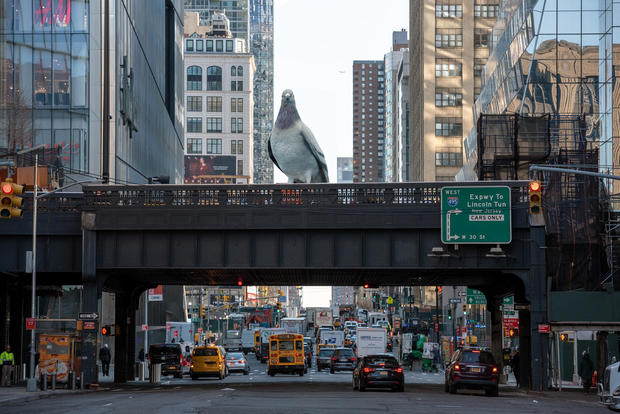Giant Sculpture of a Pigeon coming to The High Line in NYC

For the fourth High Line Plinth commission, Iván Argote presents Dinosaur (2024), a colossal, hyper-realistic sculpture of a pigeon cast in aluminum. Dinosaur was first submitted as a proposal for the High Line Plinth in 2020, among 80 proposals that included the third High Line Plinth commission, Pamela Rosenkranz’s Old Tree (2023).
The meticulously hand-painted, humorous sculpture challenges the grandeur of traditional monuments celebrating significant historical figures, instead choosing to canonize the familiar New York City street bird. Posed on a concrete plinth that resembles the sidewalks and buildings that New York’s pigeons call home, Dinosaur reverses the typical power dynamic between bird and human, towering 21 feet above the Spur, over the countless pedestrians and car drivers that travel down 10th Avenue.
Reflecting on the work’s title, Argote notes, “The name Dinosaur makes reference to the sculpture’s scale and to the pigeon’s ancestors who millions of years ago dominated the globe, as we humans do today… the name also serves as a reference to the dinosaur’s extinction. Like them, one day we won’t be around anymore, but perhaps a remnant of humanity will live on—as pigeons do—in the dark corners and gaps of future worlds. I feel this sculpture could generate an uncanny feeling of attraction, seduction, and fear among the inhabitants of New York.”
Dinosaur, like the pigeons that inspired it, bears witness to the city’s evolution and confronts us with our ever-changing relationship with the natural world and its inhabitants. The oft-overlooked and derided creatures that seem to over-populate the city first arrived in the US via Europe, likely in the 1800s. They were kept as domesticated animals and were most notably used as reliable message carriers. Pigeons have an internal GPS, known as “homing,” that allows them to always find their way back home. This skill once made the bird indispensable in war—they served as military messengers in both World War I and World War II, saving hundreds of soldiers’ lives by transporting messages quickly to both the trenches and front lines. Many of these pigeons received gallantry awards and were celebrated as war heroes, before technology eventually rendered them obsolete.
Dinosaur recognizes this seemingly prosaic figure and celebrates its anonymity amongst the urban landscape, while also taking aim at classic monuments erected in honor of great men, who all too often are neither honorable nor great. Argote humorously suggests that, in fact, the not-wild—but no longer domesticated—birds are likely more deserving of being placed on a pedestal and celebrated for their contributions to society than most. Further, by highlighting their origins, Argote reminds viewers that, to some degree, everyone is an immigrant. Even the pigeon, a New York fixture, initially migrated here and made the city their home, like millions of other “native” New Yorkers.
Iván Argote is the first Plinth artist from the global south, and the youngest yet. His work as an artist and filmmaker is heavily focused on social justice issues and historical processes, sometimes inspired by his childhood in Bogotá, as he grew up in a family with a long tradition of political and social activism, from the 1950s to the present. Through his sculptures, installations, films, and interventions, Argote questions our intimate relationship with others, institutions, power, and belief systems. His work foregrounds tenderness and humor, through which he is able to present a critical approach to dominant historical narratives and patterns. In his interventions on monuments, large-scale installations, and performances, Argote proposes new symbolic uses of public space, and challenges our traditional and accepted ideas of whom and what we memorialize, revere, and remember.
Main Image: Iván Argote, Dinosaur, Rendering courtesy of the artist.
